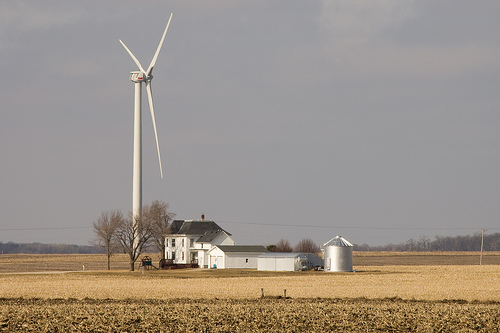 A wind turbine near a home in rural Lee County, Illinois.Photo: Mark EllisThis is an abridged version of a story that originally appeared on Midwest Energy News.
A wind turbine near a home in rural Lee County, Illinois.Photo: Mark EllisThis is an abridged version of a story that originally appeared on Midwest Energy News.
This year, a new Wisconsin state law takes effect* that wind energy advocates call an important step — and even a national model — for alleviating the chaotic and shifting patchwork of municipal and county siting regulations that can create great uncertainty and moving goalposts for wind developers.
The rule, drafted by the state’s Public Service Commission at the behest of state legislators, sets a limit on how stringent siting and other regulations can be for wind farms under 100 megawatts, but still gives local governments the opportunity to appeal for an exception.
Many states have an agency that issues permits for all major wind farms on a case-by-case basis. However, most states lack uniform, enforceable standards governing wind turbine siting, leaving regulatory decisions to local governments.
This is seldom an issue when wind farms are built in remote areas. But in more densely populated parts of the Midwest, disputes over wind farms have prompted local governments to pass rules that wind proponents say are often driven more by local politics and vocal activists than sound science.
In response, wind developers and advocates are increasingly discussing statewide standards or guidelines — like Wisconsin’s new rules — that still allow local input while imposing some objectivity and uniformity on the siting process.
Michael Vickerman, executive director of RENEW Wisconsin, a nonprofit that promotes clean energy, said the law — the result of a three-year process involving advocates, developers, and state and local officials — should be key in helping the state continue to develop its ample wind resources and prevent local governments from passing “de facto moratoria” on wind farms, as has happened throughout the Midwest in recent years.
“We have seen many, many cases where local governments went way overboard and adopted setbacks that were basically designed to stop projects before they could get a foothold — the equivalent of electric fences around the county saying, ‘Danger, wind developers — keep out,'” he said.
Chuck Burdick, senior wind energy developer at Minneapolis-based National Wind, wishes Minnesota would adopt a rule similar to Wisconsin’s. National Wind’s proposed 78-megawatt wind farm in Goodhue County is in limbo since county officials in October passed an ordinance mandating setbacks of 10 rotor diameters — about 2,700 feet for National Wind’s project — from non-participating landowners. (Wisconsin’s rules limit setbacks to no more than 1,250 feet.)
A judge will decide whether Minnesota should abide by the county’s rule. Meanwhile, the delay is jeopardizing federal stimulus funding that is contingent on the $180 million project going online by the end of 2011.
“We’d been pursuing this permit for a year well in excess of existing rules, then at the last minute the rules changed under us,” said Burdick, noting that the state Public Utility Commission has approved several other wind farms with 1,000-foot setbacks in recent months. “This is just ridiculous, it’s an absurdly large setback the county is asking for, and it’s not about health or safety, it’s about politics.”
Restrictive local ordinances are often prompted by the experiences of people who live near large wind farms.
Neighbors of a wind farm built by NextEra Energy Resources in DeKalb, Ill., say turbines 1,400 feet from their home create disturbing shadow flickers and mechanical droning and whooshing noises that keep them up at night.
Dave and Stephanie Hulthen, who write a blog called Life With DeKalb Turbines, stress they don’t oppose wind energy, but feel their lives have been greatly altered by the noise and stress created by turbines that, they say, are way too close.
“I was born and raised here, it was always peaceful, it was my sanctuary,” said Dave Hulthen, 34, who works as a cabinet-maker and roofing consultant. “Now we have to come home to this — it puts a whole other stress on your life. I don’t sleep like I used to, and when you suffer sleep deprivation it affects all other areas of your life.”
About 40 landowners near the NextEra wind farm are suing the company and the county board that granted zoning approval, and a number of Illinois counties have proposed restrictive ordinances limiting wind farms, likely influenced by opposition to the NextEra project. A NextEra spokesman said he couldn’t comment on the situation because of the lawsuit.
Kevin Borgia, director of the Illinois Wind Energy Association, said he hopes isolated cases of wind-farm opposition don’t torpedo support for wind energy in general.
“If you ask me, counties need to know what they’re giving up if they were to propose such a restrictive standard,” he said. “People who think wind farms are an industrialization of a rural landscape don’t want to see them. If you get enough people in a county who don’t want wind farms, they have a democratic right to prevent them. But those people lose a lot — the property tax revenue that won’t come in, the landowners who won’t be paid, the jobs that won’t come in, the clean energy that could have been generated.”
Jamie Karnik, spokesperson for advocacy group Wind on the Wires, said that especially in states where people have less direct experience with wind energy, educating residents about the realities and benefits of wind power is a key part of drafting uniform standards with popular support.
“We’re seeing this come up more and more,” he said. “In the past we’ve developed often where there’s a lot of wind and not a lot of people. But as projects move closer to populated areas, this becomes more of an issue. And we are starting to figure it out.”
Correction: An earlier version of this story incorrectly stated the law would take effect Jan. 1. The law won’t go into effect until at least March 1.



